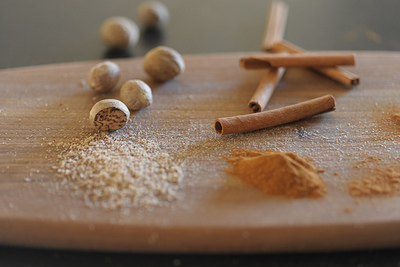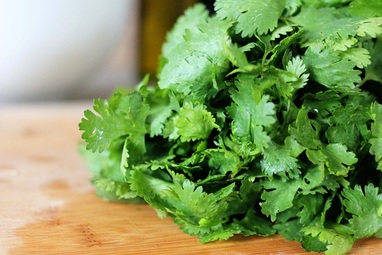Herbs and spices can be both dried and fresh. When stocking up your spice shelf/cabinet/pantry/vault (I don't judge), there are some classic dried varieties that I always keep on hand because of how versatile they are. Warming classics like cinnamon, nutmeg, and ginger are very popular in the fall and winter, while others like oregano are easily used year-round. In the fridge, there are also some fresh herbs and flavoring ingredients that you should keep on hand for quickly adding flavor to meals. So what should you buy fresh, what should you buy dry, and what should you maybe skip getting until you need it? Let's find out.
**For full disclosure, I was told by one of my friends that this post would not be complete unless I linked The Spice Girls Classic Spice Up Your Life to it. So, if you would like to experience the full audio-visual experience, open up the song in another tab and jam out my friends. **
Always Have on Hand
In The Cabinet
Herbs:
Dried Oregano: An Italian staple. Excellent in tomato based sauces, with meats, stews, and frequently seen in many recipes for sauces and more.
Dried Basil: Another Italian staple, it provides a slight sweetness and plays well with oregano when used in sauces and soups.
Dried Thyme: Many poultry dishes feature thyme for the woody, slightly citrusy flavor it brings to the table. Chicken dishes braised or cooked in sauces is where dried thyme can really shine.
Spices:
Whole Nutmeg: A woodier, spicier, peppier cousin to cinnamon. It often plays a secondary player to cinnamon in many drinks and dishes because of the complementary flavors it has compared to its counterpart. Buy them whole and use a grater or microplane to grate it fresh.
Garlic Powder: In dishes where you may need just a hint of garlic or if you do not feel like going through the hassle dirtying a cutting board and knife just for a little garlic bite, having some garlic powder on hand can be a lifesaver. Just remember that for the flavors to come out, you will need some moisture when cooking with garlic powder and some salt as well. A sprinkle and a shake can bring big flavor to an otherwise bland dish.
Curry Powder: Feeling bold? Curry powders are blend of a number of spices like tumeric, garam masala, cardamom, and many more that can create a flavor ranging from mild to fiery hot. A staple of Indian and Southeast Asian cuisine, a little of this spice mix can go a long way, so experiment as you will.
Red Pepper Flake: If you want to add some simple heat to a dish, a sprinkle or pinch of red pepper flake can do the trick. On top of pizza or in a pasta dish, red pepper flake is something you will be glad to have on hand.
Other Staples:
Bouillon Powder: Out of canned broth or simply want to cook your food in something tastier than just plain water? Dissolving in some bouillon powder will remeby that. Chicken will be the most used one for most people. The mild flavor will add richness to soups, rice dishes, and more without overpowering the other ingredients like other varieties like beef can. A teaspoon of powder for every 1-2cups of water is good place to start.
In The Fridge
Green Onion: Need a little mild bite of onion just to bring some freshness to a dish? Some thinly sliced green onion will do the trick. On top of a baked potato, on noodles, or on almost anything for that matter, green onion will be right at home. Also, contrary to many rumors, both the green AND white parts are perfectly edible.
Buy When Needed
In the Cabinet
Most other Spices and Dried Herbs: Sure, dill, marjoram, and others may sound fun to have, but most recipes that you encounter will not call for them very often. What will happen is that a jar will just sit in your cabinet and grow stale. Over time and as you cook more and more, you will notice what herbs and spices you use more often and you can adjust and buy these staples as you see fit. Just remember, unlike whole spices, dried herbs and ground spices can go stale and should be replaced every two years or so if you have not finished them.
In The Fridge
Woody Herbs (Thyme, Rosemary): Like their leafy counterparts, woody stemmed herbs don't keep for more than a few weeks. Buy when needed.
Fresh Ginger: If you are very interested in Asian cooking or like to make ginger tea to keep yourself warm in the winter, it may be worth buying a root or a piece of a "Hand" of ginger to keep on hand in the door of your fridge. Otherwise, break off and buy a small nub of ginger when a recipe calls for it. It's cheap, bold, and worth getting the fresh stuff.
Fresh Chile Peppers: Peppers like Jalepenos, Habaneros, and more can really bring in a big bite of heat to a dish. But unless you are big on this heat, it is best to just buy a few when necessary and use while fresh.
Where to Buy
One of these places is the international foods aisle. If you live in a area with a large immigrant population, chance are, your grocery store will have a well stocked international section featuring jars and bags of the very same spices in the baking isle but at half or even more off. While you may not have heard of the brand before, the herbs and spices here will give you the same flavors for much less. You may need to invest in some clever storage solutions to hold all these spices, but that is a one-time investment and it makes you look like a real pro when you open up your well stocked cabinet to awe struck friends.
If you are very lucky, you may even have access to a full international supermarket in your neighborhood. Living in the DC area, Chinese, Korean , Spanish, and Middle Eastern markets abound. These markets are treasure troves for cheap produce and cheap and plentiful herbs and spices. The only challenge here may be that items may not be labeled clearly in English and you might have to go solely on sight. This may be easier for recognizable spices like stick cinnamon, but other things like powdered spices may be harder to find and figure out. If you're feeling confident, ethnic supermarkets are a treasure trove of possibility.
Storage
Store your dried herbs and spices in dark, dry areas to make sure they stay as fresh as possible. You want to make sure containers are air-tight to prevent things from going stale. If you have a cabinet away from the stove or sink, that would be ideal.
As for fresh herbs, they like to be treated a bit more gently than most ingredients. For leafy herbs like basil, parsley, or cilantro, store them in the top shelf of your fridge or even on your counter in a small jar of water like flowers. There are extra fancy devices for herb storage, but unless you really are passionate about your purchases, these really are not necessary. For more woody stemmed herbs like Rosemary and Thyme, you want to make sure they are as dry as possible before storing them on the top shelf of the fridge or on the top sections of the fridge door in a zip bag. Herbs don't take to extreme cold very well so I would avoid the lower areas of the fridge.
Hearty items like fresh bulbs of garlic and ginger should also be stored in cool, dark, dry places but not in the fridge. If you have a drawer away from the stove and sink, these are ideal areas to have these staples.
You may be wondering why there is so much hassle and difference between storing all these different herbs and spices in different places. This is because different ingredients take best to different environments. A palm tree would survive and last much longer in warm, temperate Florida versus the mountains of Vermont. It would be a shame to have to throw away half of your purchase because it spoiled early due to improper storage. Waste not want not.
I hope you gained some useful knowledge about some of the best supporting actors in your kitchen: herbs and spices. In my next post, I'll be exploring some classic flavor combinations for you to play around with. If you have questions or want to know more, comment below or shoot me a message.
Cheers.






